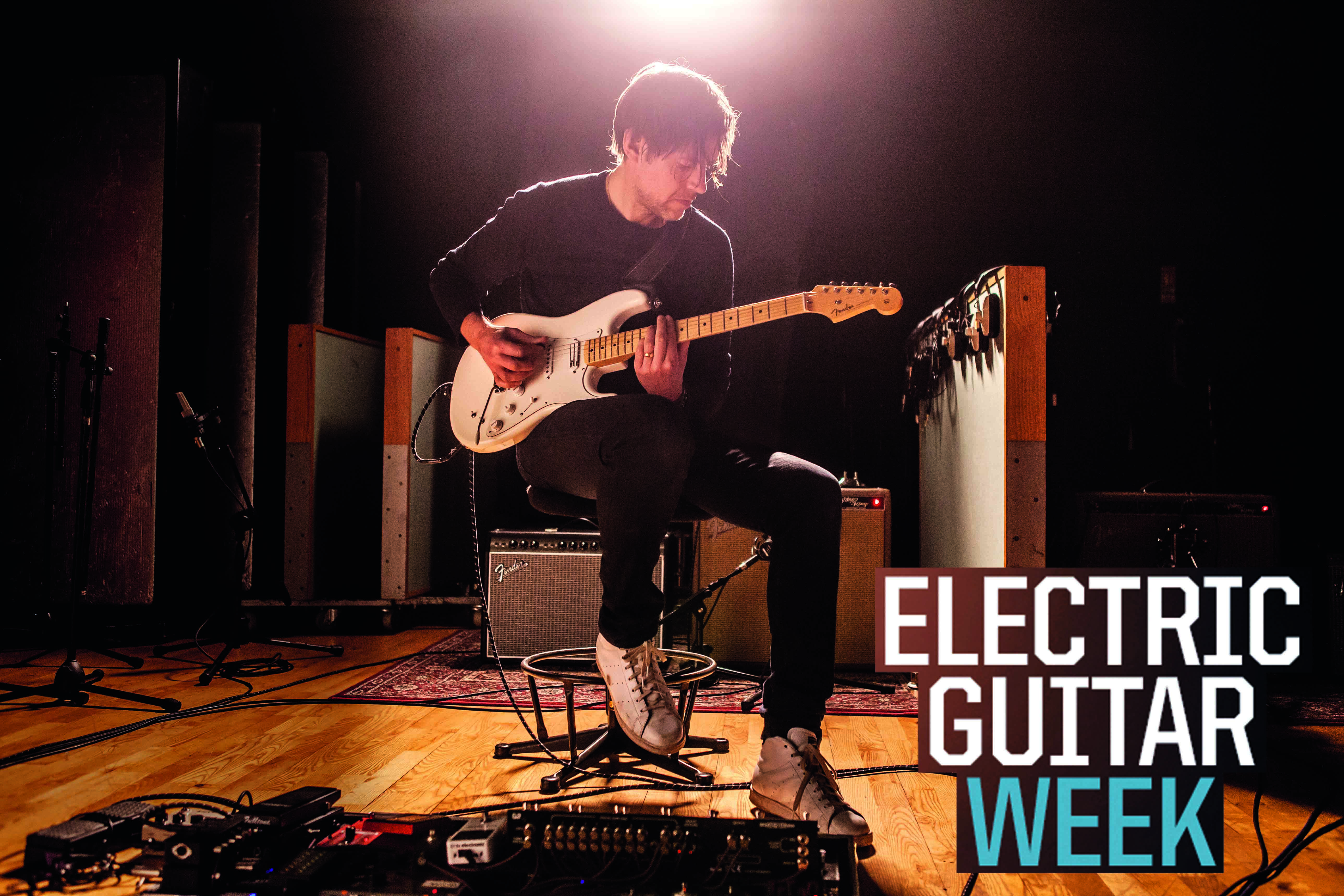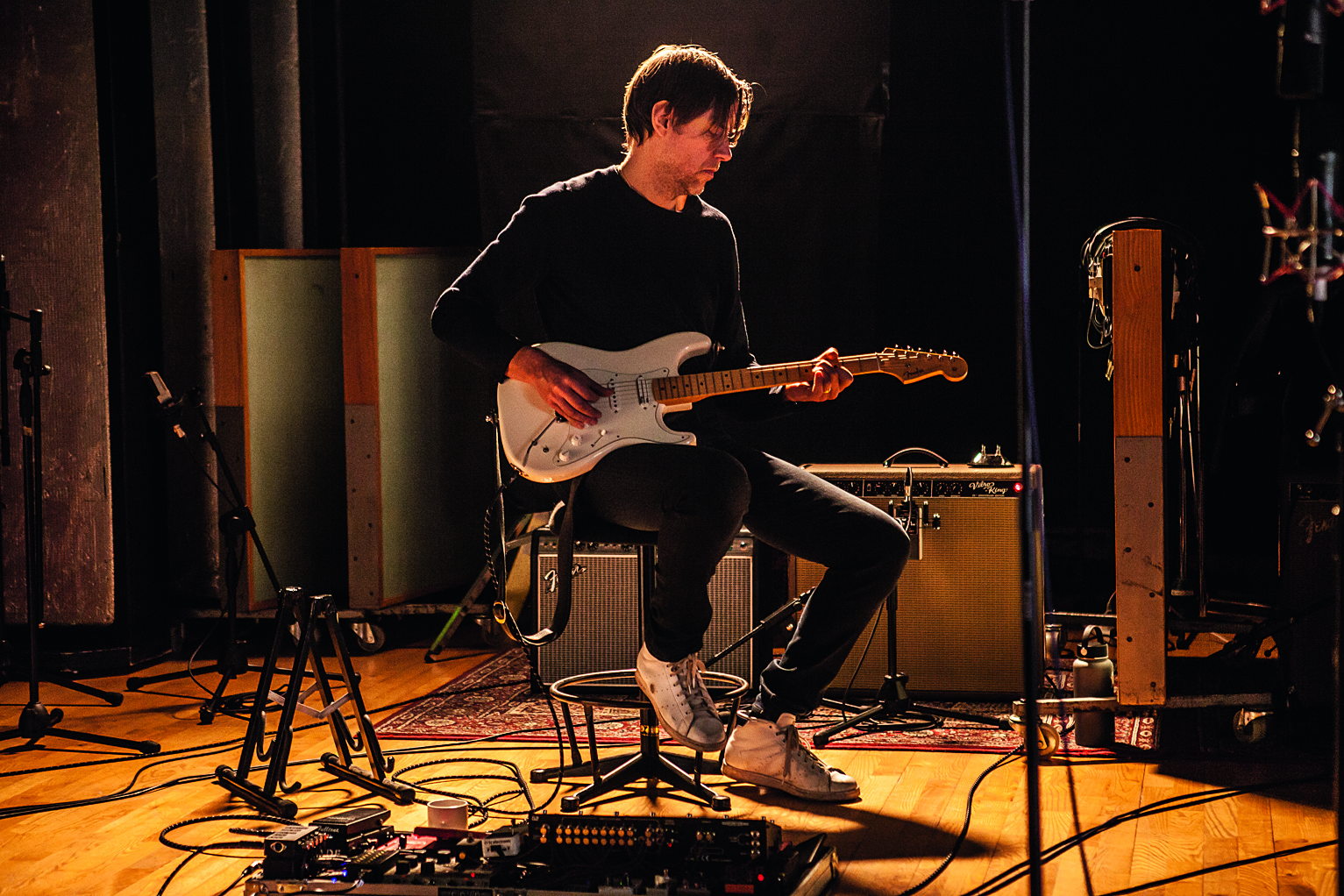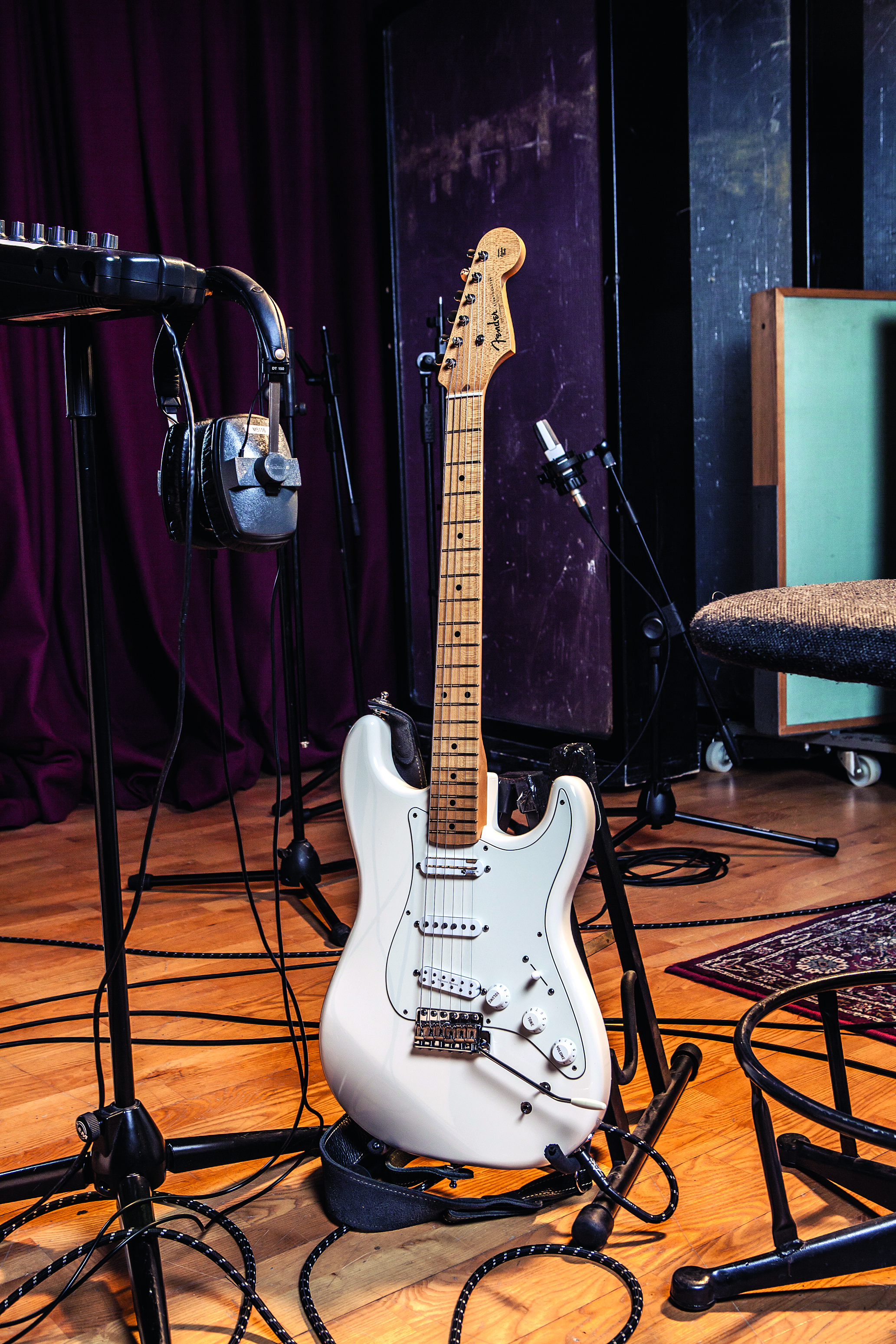"I needed to have a guitar that can make many different sounds and has the potential to go into lots of different areas" – Radiohead's Ed O'Brien talks Strats
An in-depth chat with the pioneering player about his signature Fender guitar

ELECTRIC GUITAR WEEK: It’s hard not to get caught up in a little hysteria when talking about Radiohead. But their body of work tells a remarkable story; of five Oxford school friends who have never wasted a chance to push forward and change our expectations of what’s possible in a band.
A three-guitar lineup of very different players, they constantly challenge each other and themselves to find new sonic spaces. To the left of Jonny Greenwood and Thom Yorke is their somewhat secret weapon; a player whose love for the guitar shines through in a willingness to pioneer with sounds like his own heroes did in the 80s.
So when it was announced that Ed O’Brien had worked with Fender on the collaborative guitar with the EOB Sustainer Stratocaster we were all ears and eager to find out more.
Electric Guitar Week is brought to you in association with Fender. Check out the Electric Guitar Week hub page for more tips and tutorials.
At the start of the band did you choose the Strat, or did it choose you?
“I chose the Strat, I think. The first guitar I bought, when we formed the band back in 1985, was a Westone Spectrum DX. It was all black, and Colin [Greenwood] had the matching bass. And it looked wicked, with coil splits. I cottoned on pretty quickly that it wasn’t that nice to play... so the next guitar that I bought at the beginning of ’87 was a Squier Strat and that was enough. That was all I had until we got signed in 1991. And I didn’t need anything else because I had a Strat; it was great. It did the job.
“So I’ve always liked Strats. Jonny [Greenwood] would take the piss out of me a bit with it being a bit ‘rock’ or something. I had a Rickenbacker as well so I think that offset it. I loved the yin and the yang [of that] and when you wanted to finesse something or do something really beautiful, you’d pull out the Strat. It was brilliant
with effects.”
Want all the hottest music and gear news, reviews, deals, features and more, direct to your inbox? Sign up here.
How did the idea for a signature Strat come about?
“It was early 2013. I literally had a dream about it – a really strong, compelling dream, and I woke up and I immediately wrote an email to Neil [Whitcher, head of Fender artist relations], who I knew through Johnny Marr. And I said, ‘Listen, I’ve been playing this guitar...’. I’d never had any desire to do anything like this before at all, but the dream was so strong and it was complete; it was like, ‘I kind of have to do this.’
I literally had a dream about it – a really strong, compelling dream
"So I wrote to Neil and he passed it on to his boss, [senior vice president] Justin Norvell and it was about the story of the guitar and what I wanted to do. And a big part of it was that when you’re young, as a player, you usually start off on a budget, but there’s one guitar where you make the step up, you save up, and that’s what I’m hoping this guitar might be: something that young players can get their hands on.
“And it’s fantastic. It’s got the Seymour Duncan JB Jr, it’s got a Texas Special pickup in there; it’s a great-sounding Strat, and it looks amazing but at the flick of a switch you enter another world. And so my whole thing with them was like, ‘I’m not interested in doing a signature’; for a start, I don’t feel I’m worthy of that – people like Johnny Marr, all those people who do it are sort of different. I wanted to do a collaboration.”

It represents something of an evolution for such a classic guitar...
“I didn’t want the [EOB Sustainer Stratocaster] to be a like a classic Strat; I know there’s an argument that says low output Strats are the way to go – maybe that’s somewhere I’ll go to in the future – but I love those Lace Sensor pickups. I really love the clarity of them and distortion wise they’re brilliant – the Texas Special pickup is very similar in that way.
“I don’t like that really top-y bridge pickup sound on Strats but I like the attack from the bridge and I wanted the sound to be more middle-y, so Alex Perez, who built the prototypes in the [Fender] Custom Shop, came up with the idea of using the Seymour Duncan JB Junior. The whole thing was a collaboration with Fender. I know what I like and will respond to it, but I needed their help. Alex was very good at interpreting what I needed.”
The neck is nice and chunky, too.
“That’s really cool isn’t it? Everyone says they love the neck. It’s a ’56 profile, which is something you can normally only get from the Fender Custom Shop. I wanted a neck that was big enough for my hands – because I’ve got big hands – but not too big for somebody else.
"It’s all been about getting something that feels right. I wanted something that was chunky, but not too big or too much of a struggle. The satin finish was a really important thing; you know when you get a new neck and sand it down to get it feeling better? Fender said we didn’t have to do that – we could have it satin.
“I knew what I didn’t like about new guitars, but I was also excited about doing something that was a new concept. When I was putting it together I didn’t know what neck I wanted so I went to the Custom Shop in Corona, which was amazing because I never had the knowledge or the inclination to find out before.
"I’d go into somewhere like Vintage ‘n’ Rare Guitars and feel a load of necks and go, ‘Oh that Casino feels great,’ or, ‘That sounds great,’ but I’ve never been a student of that kind of thing. In fact Radiohead was a kind of anti-gear, anti- vintage stuff sort of band, although we’ve got some nice equipment now. Lots of people venerated guitars like a ’59 Les Paul, but we didn’t know about any of this stuff until about 10 years ago."
You seem open-minded to vintage and modern gear – the EOB Sustainer Stratocaster appears to combine both.
“Yeah, exactly – merging it all together and not being precious and not being a snob about anything, old or new. There’s amazing stuff being made now and there’s amazing stuff that was made years ago. I think people who are always searching
for sounds would love it. I know what it’s like as a musician; you want to be inspired by a sound – that’s what you’re after. Somebody could be as dramatic and anarchic with this guitar as they want to be, but also approach it in a more Eno- esque, atmospheric way, which is where I come from.
“It’s got the potential for lots of different sounds. It’s got all the normal things, but if you engage the sustainer you’ve got a whole other world. [Ed demonstrates the Fernandes Sustainer] You know the controls? There’s a two-way on/off switch and a three-way switch: pulled to you it’s unison, in the middle setting it’s a fifth (that often fades in) and the other setting is an octave up that’s super hot, but you can wind it down.”
I know what it’s like as a musician; you want to be inspired by a sound – that’s what you’re after
There must be a lot of potential for using it in different ways, stylistically?
“Yeah, I didn’t want it just to be a great sustainer, I wanted it to be a great guitar all round and I wanted it to feel great. I wanted it to be white and look great. I wanted it to be a complete no-brainer! It’s different and it’s a bit left of centre, but it’s all about the attitude – you bring your character to it. You bring your mood to it. It’s the way you approach it and that, for me, is really important. I always make the music that I want to hear and with this guitar we’ve designed something that I want to play.
“It was really important that it was priced decently because I wanted it to be like somebody’s ‘first proper guitar’. You know, like when you were younger? My first guitar was [that] Westone Spectrum DX: Colin [Greenwood] had a matching bass in black and we’d just formed the band in 1985, but it wasn’t cool enough! The first guitar I bought that was more on a level was a Squier Strat and that was important for me, because it was a ‘proper’ guitar. It was a black, maple neck Japanese Strat with a white scratchplate; but it got stolen with all of our gear in 1995. I played it on The Bends – I had it right up until then.”

Have you found the guitar to be a useful addition to the Radiohead rig?
“I was taking 12 guitars out on tour with me; although I didn’t use a guitar per song I’d change guitars a lot and I was getting fed up with it. I played a prototype on tour all last year and the difference now is that 60-70 per cent of the set is played on [the EOB Sustainer Stratocaster], which is great.
“I didn’t want to just have a sustainer guitar; I wanted a guitar that could do all
of the things that I wanted to do on a normal guitar – arpeggios and that kind of thing. I wanted something that was versatile.
"You’ve got your character guitars, but in the band I needed to have a guitar that can make many different sounds and has the potential to go into lots of different areas. If there’s a certain part of a song I’m playing that needs a guitar change, then I will, but I wanted to have something that can do a lot more than the rest.”
Do you think this Strat will enable you to experiment further and enhance your own creativity?
“Massively. I’ve already started experimenting. I’ve been experimenting with strings in a similar way to how Sonic Youth used to, like taking two strings off and having two B strings and two bottom-E strings. I remember going to see Sonic Youth and seeing their racks of guitars – the things they would do with the guitars and the tunings: that combination with a sustainer is a whole new world! I love the guitar.
“I’ve a couple of keyboards that I love, but I really love guitar, I love gear and delays and old pedals and the combination of them, y’know? For me, the guitar feels a lot more natural than a keyboard. The whole approach. It feels a lot more intuitive. It gets me to stop thinking and start responding intuitively.”
There’s all the in-between notes and nuances with a guitar – and you can’t bend notes on a keyboard so easily.
“That’s what Elton John said: ‘You can’t bend notes on a piano’. It’s all the in- between stuff that I like. That’s a big thing: if you look at music across the world, there’s more than 12 notes.
"I love things being slightly flat and slightly sharp. And the guitar is an old instrument – it’s in our DNA. It goes back to the lyre and the lute. It’s been around a long, long time. I just love guitar. I love, love, love the sound of the guitar – the potential of the sounds that you can play.”
The Fender Ed O'Brien Sustainer Stratocaster

Neck: “So the first thing we started off on was the neck; it was great – I was sort of going up and [trying them]: everything from a Stevie Ray Vaughan neck, which is massive and it’s amazing, but I’ve got big hands, so I wanted something that filled my hands that I could still do the job with, but, obviously, I wanted it to be a guitar that people with smaller hands [could play]... It was an excuse, this guitar, to find the perfect neck for me and a neck that would work for everyone.”
Finish: “Colour was important: I really wanted it to be white. I just felt that the white suited. I didn’t quite realise, though people had told me about the lineage of the white Strat and how iconic it was, you know... the whole Hendrix thing.”
Neck pickup – Fernandes Sustainer: "The Fernandes Sustainer works in conjunction with the bridge pickup and creates a kind of magnetic field, and that’s how it works. You can’t use the single coil here – it has to be the humbucker."
Middle pickup – Fender Texas Special: “The neck sustainer was warm and round so we wanted something in between. And I liked this one because it’s a bit chime-y and to my ear it sounded sweet; it was bell-like and had depth to it.”
Bridge pickup – Seymour Duncan JB Jr humbucker: "I play mostly on the bridge pickup, so I want [it] to have some oomph on it. I don’t like thin bridge pickups... this did its thing and had attack."
Controls: “It’s very important to have a volume for the Sustainer. So you’ve got one tone control for all of the [pickups], which is fine. This seemed like a good place to [put the controls]. So you’re playing normally, and then you engage it.
"Because a lot of the time, I play, and it might be at the end of something you’re playing – for instance, it could be the end of a song with a lot of distortion and you want to keep the feedback going, and you just click it in and it keeps it going.”
Electric Guitar Week is brought to you in association with Fender. Check out the Electric Guitar Week hub page for more tips and tutorials.

Rob is the Reviews Editor for GuitarWorld.com and MusicRadar guitars, so spends most of his waking hours (and beyond) thinking about and trying the latest gear while making sure our reviews team is giving you thorough and honest tests of it. He's worked for guitar mags and sites as a writer and editor for nearly 20 years but still winces at the thought of restringing anything with a Floyd Rose.

